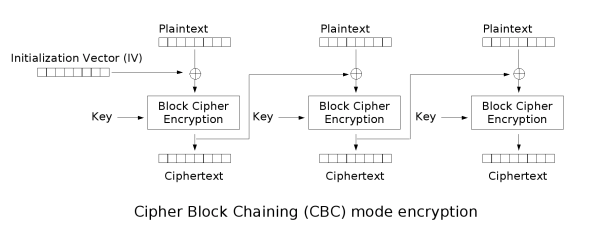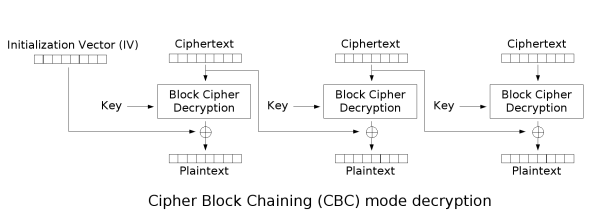CBC CBC全称为密码分组链接(Cipher-block chaining) 模式,这里
IV 不要求保密
IV 必须是不可预测的,而且要保证完整性。
加密
解密
优缺点 优点
密文块不仅和当前密文块相关,而且和前一个密文块或 IV 相关,隐藏了明文的统计特性。
具有有限的两步错误传播特性,即密文块中的一位变化只会影响当前密文块和下一密文块。
具有自同步特性,即第 k 块起密文正确,则第 k+1 块就能正常解密。
缺点
加密不能并行,解密可以并行。
应用 CBC 应用十分广泛
常见的数据加密和 TLS 加密。
完整性认证和身份认证。
攻击 字节反转攻击 原理 字节反转的原理十分简单,我们观察解密过程 可以发现如下特性:
IV 向量影响第一个明文分组
第 n 个密文分组可以影响第 n + 1 个明文分组
假设第
然后
其中
对于某个信息已知的原文和密文,然后我们可以修改第
例子 以下一个题目作为例子:
1 2 3 4 5 6 7 8 9 10 11 12 13 14 15 16 17 18 19 20 21 22 23 24 25 26 27 28 29 30 31 32 33 34 35 36 37 38 39 40 41 42 43 44 45 46 47 48 from flag import FLAGfrom Crypto.Cipher import AESfrom Crypto import Randomimport base64BLOCK_SIZE=16 IV = Random.new().read(BLOCK_SIZE) passphrase = Random.new().read(BLOCK_SIZE) pad = lambda s: s + (BLOCK_SIZE - len (s) % BLOCK_SIZE) * chr (BLOCK_SIZE - len (s) % BLOCK_SIZE) unpad = lambda s: s[:-ord (s[len (s) - 1 :])] prefix = "flag=" +FLAG+"&userdata=" suffix = "&user=guest" def menu (): print "1. encrypt" print "2. decrypt" return raw_input("> " ) def encrypt (): data = raw_input("your data: " ) plain = prefix+data+suffix aes = AES.new(passphrase, AES.MODE_CBC, IV) print base64.b64encode(aes.encrypt(pad(plain))) def decrypt (): data = raw_input("input data: " ) aes = AES.new(passphrase, AES.MODE_CBC, IV) plain = unpad(aes.decrypt(base64.b64decode(data))) print 'DEBUG ====> ' + plain if plain[-5 :]=="admin" : print plain else : print "you are not admin" def main (): for _ in range (10 ): cmd = menu() if cmd=="1" : encrypt() elif cmd=="2" : decrypt() else : exit() if __name__=="__main__" : main()
可见题目希望我们提供一个加密的字符串,如果这个字符串解密后最后的内容为admin。程序将会输出明文。所以题目流程为先随便提供一个明文,然后将密文进行修改,使得解密后的字符串最后的内容为admin,我们可以枚举flag的长度来确定我们需要在什么位置进行修改。
以下是exp.py
1 2 3 4 5 6 7 8 9 10 11 12 13 14 15 16 17 18 19 20 21 22 23 24 25 26 27 28 29 30 31 32 33 34 35 from pwn import *import base64pad = 16 data = 'a' * pad for x in range (10 , 100 ): r = remote('xxx.xxx.xxx.xxx' , 10004 ) r.sendlineafter('> ' , '1' ) r.sendlineafter('your data: ' , data) cipher = list (base64.b64decode(r.recv())) BLOCK_SIZE = 16 prefix = "flag=" + 'a' * x + "&userdata=" suffix = "&user=guest" plain = prefix + data + suffix idx = (22 + x + pad) % BLOCK_SIZE + ((22 + x + pad) / BLOCK_SIZE - 1 ) * BLOCK_SIZE cipher[idx + 0 ] = chr (ord (cipher[idx + 0 ]) ^ ord ('g' ) ^ ord ('a' )) cipher[idx + 1 ] = chr (ord (cipher[idx + 1 ]) ^ ord ('u' ) ^ ord ('d' )) cipher[idx + 2 ] = chr (ord (cipher[idx + 2 ]) ^ ord ('e' ) ^ ord ('m' )) cipher[idx + 3 ] = chr (ord (cipher[idx + 3 ]) ^ ord ('s' ) ^ ord ('i' )) cipher[idx + 4 ] = chr (ord (cipher[idx + 4 ]) ^ ord ('t' ) ^ ord ('n' )) r.sendlineafter('> ' , '2' ) r.sendlineafter('input data: ' , base64.b64encode('' .join(cipher))) msg = r.recvline() if 'you are not admin' not in msg: print msg break r.close()
Padding Oracle Attack 原理 Padding Oracle Attack 除了利用了字节反转攻击 的原理之外,还利用了另一个特性。那就是密码加密时,必须保证明文的长度为某个
如果满足这个要求,仍会添加
例如如果要加密admin这个明文,admin\x03\x03\x03再进行加密。
所在解密时,需要判断解密出来的密文是否合法,假设有一台服务器允许我们提交密文,然后服务器会返回这是否是一个合法的密文,那么这时候就存在Padding Oracle Attack。
Padding Oracle Attack的功能是:我们现在有一个合法的密文,然后我们可以用Padding Oracle Attack得到全部明文。
我在这里采用与上面字节翻转攻击 相同的记号。
假设我们总共有密文合法 时。假设deadbeef。
那么我们提交的第
因为我们只修改了第
我们假设此时我们枚举到的数为
按照这个思路,我们可以枚举倒数第二,第三个字节,求出全部的
例子 放一道模板题方便理解吧
1 2 3 4 5 6 7 8 9 10 11 12 13 14 15 16 17 18 19 20 21 22 23 24 25 26 27 28 29 30 31 32 33 34 35 36 37 38 39 40 41 42 43 44 45 46 47 48 49 50 51 52 53 54 55 56 from flag import FLAGfrom Crypto.Cipher import AESfrom Crypto import Randomimport base64BLOCK_SIZE=16 IV = Random.new().read(BLOCK_SIZE) passphrase = Random.new().read(BLOCK_SIZE) pad = lambda s: s + (BLOCK_SIZE - len (s) % BLOCK_SIZE) * \ chr (BLOCK_SIZE - len (s) % BLOCK_SIZE) suffix = "flag=" +FLAG def unpad (data ): padlen=ord (data[-1 ]) if padlen<1 or padlen>BLOCK_SIZE: return None for i in range (1 ,padlen): if data[-1 -i]!=chr (padlen): return None return data[:-padlen] def decrypt (): data = raw_input("input your data: " ) aes = AES.new(passphrase, AES.MODE_CBC, IV) plain = unpad(aes.decrypt(base64.b64decode(data))) if plain==None : print "KO" else : print "OK" def encrypt (): data = raw_input("input your data: " ) plain = data+suffix aes = AES.new(passphrase, AES.MODE_CBC, IV) print base64.b64encode(aes.encrypt(pad(plain))) def menu (): print "1 for encrypt" print "2 for decrypt" return raw_input("> " ) def main (): while True : option = menu() if option=="1" : encrypt() elif option=="2" : decrypt() else : exit() if __name__=="__main__" : main()
exp.py
1 2 3 4 5 6 7 8 9 10 11 12 13 14 15 16 17 18 19 20 21 22 23 24 25 26 27 28 29 30 31 32 33 34 35 36 37 38 39 40 41 42 43 44 45 from pwn import *import base64r = remote('xxx.xxx.xxx.xxx' , 10005 ) def encrypt (data ): r.sendlineafter('> ' , '1' ) r.sendlineafter('data: ' , data) cipher = r.recv() cipher = base64.b64decode(cipher) return cipher def decrypt (data ): r.sendlineafter('> ' , '2' ) r.sendlineafter('data: ' , data) val = r.recv() return 'OK' in val block_size = 16 cipher = encrypt('a' * 12 ) count = len (cipher) / block_size middle = [0 for i in range (len (cipher))] def exp (x ): data, plain0 = list (cipher[0 : (x + 2 ) * block_size]), '' for e in range (1 , block_size + 1 ): ind = (x + 1 ) * block_size - e for c in range (256 ): data[ind] = chr (c) if decrypt(base64.b64encode('' .join(data))): middle[ind + block_size] = chr (e ^ c) plain0 += chr (c ^ e ^ ord (cipher[ind])) for y in range (e): data[ind + y] = chr (ord (middle[ind + y + block_size]) ^ (e + 1 )) break print plain0[::-1 ] for x in range (0 , count - 1 ): exp(x) r.interactive()


